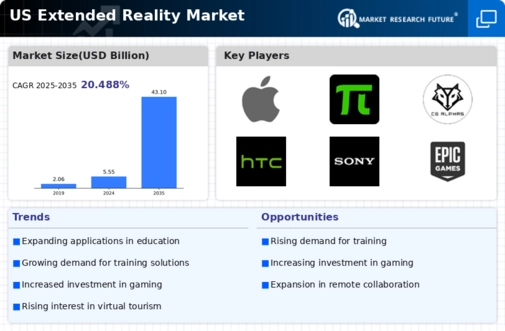The extended reality market is currently characterized by a dynamic competitive landscape, driven by rapid technological advancements and increasing consumer demand for immersive experiences. Major players such as Meta Platforms (US), Microsoft (US), and Apple (US) are at the forefront, each adopting distinct strategies to enhance their market positioning. Meta Platforms (US) continues to focus on innovation in virtual reality (VR) through its Oculus line, while Microsoft (US) emphasizes augmented reality (AR) with its HoloLens, targeting enterprise applications. Apple (US), on the other hand, appears to be gearing up for a significant entry into the market with its anticipated mixed-reality headset, suggesting a strategic pivot towards consumer-oriented solutions. Collectively, these strategies indicate a competitive environment that is increasingly centered on technological differentiation and user engagement.
Key business tactics within the extended reality market include localized manufacturing and supply chain optimization, which are essential for meeting the growing demand for hardware and software solutions. The market structure is moderately fragmented, with a mix of established players and emerging startups. This fragmentation allows for diverse innovation pathways, although the influence of key players remains substantial, shaping industry standards and consumer expectations.
In October 2025, Meta Platforms (US) announced a partnership with a leading gaming studio to develop exclusive VR content, which is expected to enhance user engagement and drive hardware sales. This strategic move underscores Meta's commitment to creating a robust ecosystem around its VR offerings, potentially increasing its market share in a competitive landscape. The focus on exclusive content may also serve to differentiate its products from those of competitors, fostering brand loyalty among users.
In September 2025, Microsoft (US) unveiled a new version of its HoloLens, featuring enhanced capabilities for enterprise applications, particularly in remote collaboration and training. This development is strategically significant as it reinforces Microsoft's position in the enterprise segment of the market, where demand for AR solutions is surging. By continuously improving its product offerings, Microsoft aims to solidify its leadership in the professional sector, which could lead to increased adoption rates among businesses seeking innovative solutions.
In August 2025, Apple (US) revealed plans to launch its mixed-reality headset in early 2026, generating considerable anticipation in the market. This strategic action indicates Apple's intent to leverage its extensive ecosystem and brand loyalty to capture a significant share of the consumer market. The integration of advanced features and seamless connectivity with existing Apple devices may position the company favorably against its competitors, potentially reshaping consumer expectations in the extended reality space.
As of November 2025, current competitive trends are increasingly defined by digitalization, sustainability, and the integration of artificial intelligence (AI) into extended reality applications. Strategic alliances are becoming more prevalent, as companies recognize the value of collaboration in enhancing technological capabilities and market reach. Looking ahead, competitive differentiation is likely to evolve from traditional price-based competition towards a focus on innovation, technological advancements, and supply chain reliability. This shift suggests that companies will need to invest significantly in R&D and strategic partnerships to maintain a competitive edge in an ever-evolving market.

















Leave a Comment